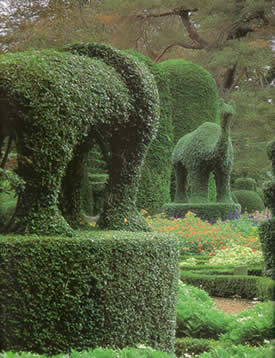Easy
activities: 
Community
projects:
Videos:
Resources
One of the older and more familiar kinds of
living sculpture, topiary is the art of growing dense,
leafy plants and pruning them into a form, or training
them over a frame, to create a three-dimensional object.
It relies on pruning and training to give shape to an
existing plant. It also can involve training a plant
to fill in a form.
Topiary is one type of living sculpture that has gone
in and out of favor through the ages.A brief history
of its importance and use:
-
Earliest references of topiary date back to 23-79
A.D.
-
It was immensely popular in Ancient Rome using cypress
trees, but after the fall of Rome, topiary fell
out of favor for several hundred years.
-
It
returned in medieval times as a way of training
fruit plants, and then was again rediscovered during
the Italian Renaissance.
-
Dutch
in the 15th century became intrigued with creating
topiary in animal shapes, as did 17th century England;
the French preferred creating topiary in geometric
designs with strict symmetry.
-
18th
century, topiary fell out of favor again, and a
natural look returned.
-
Victorians
brought back topiary, adding in new plants and details.
-
Topiary
spread to North America at Williamsburg, Virginia,
around 1690.
-
As
houseplants became popular in the 1950s and ’60s,
topiary moved indoors.
| Suggested
list of plants for indoor topiary |
| Philodendron
scandens (Heart leaf philodendron) |
Pelargonium
spp. (Scented geranium) |
Pellonia
pulchra |
|
Helxine soleirolii (Baby’s tears) |
Santolina |
Gynura
auranyiaca (Purple velvet plant) |
| Hedera
helix |
Jasminum
polyanthum |
Hoya
carnosa (Wax flower) |
| Saxifraga
stolonifera (Strawberry begonia) |
Hypoestes
phyllostachya (Polka dot plant) |
Lavendula
spp. |
| Ceropegia
woodii (Rosemary vine) |
Sedum
spp. |
Laurus
nobilis (Sweet bay) |
| Leucobrynum
glaucum (Bun moss) |
Scindapsus
aureus (Pothos) |
Argyranthemum
(Marguerite) |
| Ficus
pumila (Creeping fig) |
Pilea
microphylla (Aluminum plant) |
Rhoicissus
rhomboidea (Grape ivy) |
Topiary
tips
-
Plants with different growth habits are needed for
different types of sculpture
- Size
and texture of the plant should match the scale of
the topiary. (Small forms need small leaves, no heavy
stems)
-
Floor-standing topiary need plants with strong central
stems
- Use
care if choosing flowering plants; note flowering
time and habit
-
If using several plants, make sure they require similar
light and watering conditions
- Most
topiary plants take time to mature. Don’t expect
instant gratification
General
indoor topiary care
-
Provide adequate light
-
Watering is important because moss forms dry out easily
- Mist
moss-filled forms daily and a soak in a bucket or
a shower weekly
- Pinch
tips to promote side shoots
- If
plants get too out of control, trim them back
- Fertilize
with a water soluble houseplant fertilizer
Our
introductory activities begin with indoor
topiary, since it can be created in all seasons

Resources
Books
- Herb
Topiaries. Gallo, Sally 1992. Interweave Press, Loveland,
Colorado
- The
Complete Book of Topiary. Gallup, Barbara; Reich,
Deborah 1987. Workman Publishing, N.Y
- The
New Topiary (Longwood Gardens). Hammer, Patricia Riley
1991. Garden Art Press, East Sussex
- Quick
and Easy Indoor Topiary. Jones, Chris 1998. Storey
Books; Pownal, Vermont
Web
sites
- Horticulture
and Home Pest News - Comprehensive indoor topiary
overview from Cindy Haynes, Department of Horticulture
Iowa State University
- The
Garden Helper - List of appropriate plants for
indoor topiary use and basic topiary care suggestions
- Thomson
Topiaries - Comprehensive source of topiary frames,
plant material suggestions, and topiary construction
process
- Ladew
Topiary Gardens - Ladew Topiary Gardens is known
around the world for its topiary and flower gardens,
which include 15 thematic "garden rooms"
on 22 acres
- San
Diego Wild Animal Park Topiary - Great photos
of small, whimsical topiary- very youth friendly
- Philadelphia
Flower Show Topiary - More great photos of how
creative and unique topiary can be!
- The
European Boxwood and Topiary Society - This society
aims to increase the knowledge, appreciation, and
science of boxwood and topiary
- Photo
Gallery: Green Animals Topiary Park in Rhode Island
- This topiary garden features 80 sculptured trees
and shrubs, including animals and geometric designs
- Topiary Joe - Steel wire-framed sculpture up to 7 meters tall for topiary in the shapes of horses, herds of elephants, dragons, corporate logos and signage.
|